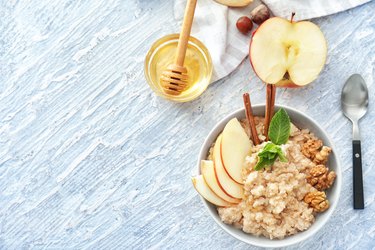
Some people prefer to skip breakfast, but a warm bowl of oatmeal with raisins and cinnamon can be a wonderful start to the day. Oats nutrition is generally balanced. Still, you have to be mindful of your oatmeal serving size, as you can have too much of a good thing.
Tip
For a 2,000-calorie diet, you can have up to 6 ounces of oatmeal to meet your daily recommended grain requirements, as per the USDA 2015-2020 Dietary Guidelines.
Video of the Day
Eat More Whole Grains
Oats come in different shapes and sizes. Refined grains have the bran and germ removed. For a healthy breakfast, choose unprocessed varieties, which contain 100 percent whole grains. Making oatmeal at home will give you full control over the ingredients used. For example, if you're on a weight loss diet, you can mix oats with stevia and vanilla protein powder for extra flavor.
Video of the Day
The USDA 2015-2020 Dietary Guidelines for Americans recommends 6 ounces of grains per day. At least half of those should come from whole grains, while less than half may come from refined grains. If you eat over 2,000 calories in a day, then you can have more than 3 ounces of whole grains. These have more fiber, minerals and vitamins compared to their refined counterparts.
Oats Nutrition Facts
Oatmeal's serving size is relatively small. One serving of Quaker Oats, for example, is only half a cup before cooking. Once cooked, the grains expand and appear larger. Quaker oats nutrition facts for one serving are as follows:
- 1 cup Quaker Oats has 150 calories
- 3 grams of fat
- 27 grams of carbohydrate
- 4 grams of fiber
- 5 grams of protein
Remember that what you add to oatmeal changes the nutrition facts. For example, there are more calories in a bowl of oatmeal with milk than in one with water. While oatmeal itself is healthy, what you add to it may not be.
The number of calories you eat per day depends on your metabolism and weight loss goals. To lose weight, you need to burn more calories than you take in and vice versa. In other words, there's no one-size-fits-all recommendation for oatmeal consumption. You can easily make the calories from oatmeal fit your total energy intake for the day.
One way to break down your diet is by carbohydrate, protein and fat intake. The Dietary Guidelines recommend that 45 to 65 percent of your daily calories come from carbs. A diet tracking app can help you determine how much oatmeal to eat per day while staying within the 45 to 65 percent range.
Benefits of Eating Oatmeal
Replacing breakfast cereals with oatmeal is an easy way to make your diet healthier, as long as you don't use a sugary product. A February 2016 research paper published in Nutrition Reviews states that the soluble fiber in oats and other whole foods may promote fullness. Therefore, oatmeal can make it easier to reduce your food intake.
Furthermore, an October 2015 study published in Nutrition Research has found that people who ate oatmeal regularly were likely to lead a healthier lifestyle. They also tended to have higher intakes of fiber and various vitamins and minerals.
The fiber in oatmeal is beneficial for your health. In a November 2014 study published in Molecular Nutrition and Food Research, subjects who ate high amounts of fiber had a 23 percent lower mortality rate than those who didn't. Their risk of certain cancers and heart disease decreased too.
Women should aim for 25 grams of fiber per day, while men should shoot for 38 grams, according to the Academy of Nutrition and Dietetics. This means that two or three servings of oatmeal in the morning can bring you to one-third of your fiber goal for the day. Just remember to use a brand that doesn't contain sugar since oatmeal is already a high-carbohydrate food.
- Academy of Nutrition and Dietetics: "Easy Ways to Boost Fiber in Your Daily Diet"
- Molecular Nutrition and Food Research: "Fiber Consumption and All‐Cause, Cardiovascular, and Cancer Mortalities: A Systematic Review and Meta‐Analysis of Cohort Studies"
- Nutrition Research: "Oatmeal Consumption Is Associated With Better Diet Quality and Lower Body Mass Index in Adults: The National Health and Nutrition Examination Survey (Nhanes), 2001-2010."
- USDA 2015-2020 Dietary Guidelines: "Appendix 7. Nutritional Goals for Age-Sex Groups Based on Dietary Reference Intakes and Dietary Guidelines Recommendations"
- Quaker Oats: "Quaker Oats Old Fashioned"
- USDA 2015-2020 Dietary Guidelines: "Key Elements of Healthy Eating Patterns"
- Nutrition Reviews: Dietary Fiber and Satiety: "The Effects of Oats on Satiety"